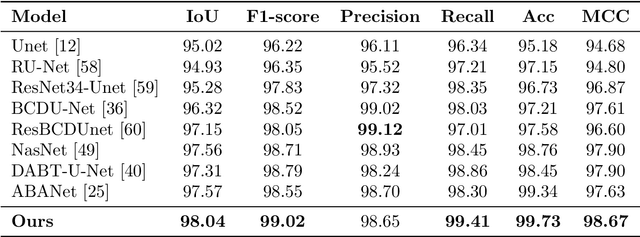Mansoor Fateh
BRISC: Annotated Dataset for Brain Tumor Segmentation and Classification with Swin-HAFNet
Jun 17, 2025Abstract:Accurate segmentation and classification of brain tumors from Magnetic Resonance Imaging (MRI) remain key challenges in medical image analysis, largely due to the lack of high-quality, balanced, and diverse datasets. In this work, we present a new curated MRI dataset designed specifically for brain tumor segmentation and classification tasks. The dataset comprises 6,000 contrast-enhanced T1-weighted MRI scans annotated by certified radiologists and physicians, spanning three major tumor types-glioma, meningioma, and pituitary-as well as non-tumorous cases. Each sample includes high-resolution labels and is categorized across axial, sagittal, and coronal imaging planes to facilitate robust model development and cross-view generalization. To demonstrate the utility of the dataset, we propose a transformer-based segmentation model and benchmark it against established baselines. Our method achieves the highest weighted mean Intersection-over-Union (IoU) of 82.3%, with improvements observed across all tumor categories. Importantly, this study serves primarily as an introduction to the dataset, establishing foundational benchmarks for future research. We envision this dataset as a valuable resource for advancing machine learning applications in neuro-oncology, supporting both academic research and clinical decision-support development. datasetlink: https://www.kaggle.com/datasets/briscdataset/brisc2025/
FusionLungNet: Multi-scale Fusion Convolution with Refinement Network for Lung CT Image Segmentation
Oct 21, 2024



Abstract:Early detection of lung cancer is crucial as it increases the chances of successful treatment. Automatic lung image segmentation assists doctors in identifying diseases such as lung cancer, COVID-19, and respiratory disorders. However, lung segmentation is challenging due to overlapping features like vascular and bronchial structures, along with pixel-level fusion of brightness, color, and texture. New lung segmentation methods face difficulties in identifying long-range relationships between image components, reliance on convolution operations that may not capture all critical features, and the complex structures of the lungs. Furthermore, semantic gaps between feature maps can hinder the integration of relevant information, reducing model accuracy. Skip connections can also limit the decoder's access to complete information, resulting in partial information loss during encoding. To overcome these challenges, we propose a hybrid approach using the FusionLungNet network, which has a multi-level structure with key components, including the ResNet-50 encoder, Channel-wise Aggregation Attention (CAA) module, Multi-scale Feature Fusion (MFF) block, self refinement (SR) module, and multiple decoders. The refinement sub-network uses convolutional neural networks for image post-processing to improve quality. Our method employs a combination of loss functions, including SSIM, IOU, and focal loss, to optimize image reconstruction quality. We created and publicly released a new dataset for lung segmentation called LungSegDB, including 1800 CT images from the LIDC-IDRI dataset (dataset version 1) and 700 images from the Chest CT Cancer Images from Kaggle dataset (dataset version 2). Our method achieved an IOU score of 98.04, outperforming existing methods and demonstrating significant improvements in segmentation accuracy. https://github.com/sadjadrz/FusionLungNet
RAT: Reinforcement-Learning-Driven and Adaptive Testing for Vulnerability Discovery in Web Application Firewalls
Dec 13, 2023Abstract:Due to the increasing sophistication of web attacks, Web Application Firewalls (WAFs) have to be tested and updated regularly to resist the relentless flow of web attacks. In practice, using a brute-force attack to discover vulnerabilities is infeasible due to the wide variety of attack patterns. Thus, various black-box testing techniques have been proposed in the literature. However, these techniques suffer from low efficiency. This paper presents Reinforcement-Learning-Driven and Adaptive Testing (RAT), an automated black-box testing strategy to discover injection vulnerabilities in WAFs. In particular, we focus on SQL injection and Cross-site Scripting, which have been among the top ten vulnerabilities over the past decade. More specifically, RAT clusters similar attack samples together. It then utilizes a reinforcement learning technique combined with a novel adaptive search algorithm to discover almost all bypassing attack patterns efficiently. We compare RAT with three state-of-the-art methods considering their objectives. The experiments show that RAT performs 33.53% and 63.16% on average better than its counterparts in discovering the most possible bypassing payloads and reducing the number of attempts before finding the first bypassing payload when testing well-configured WAFs, respectively.
 Add to Chrome
Add to Chrome Add to Firefox
Add to Firefox Add to Edge
Add to Edge